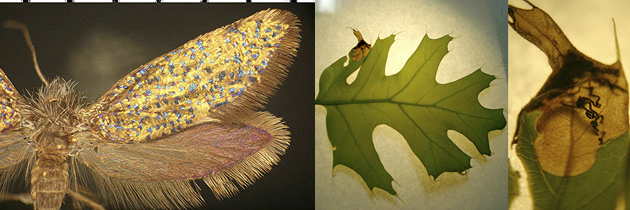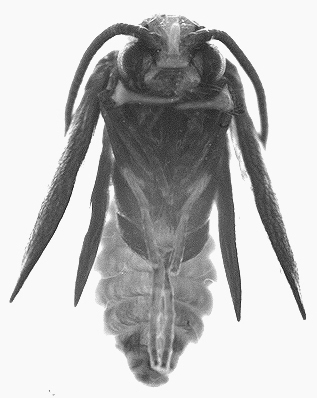
Figure 1. Dyseriocrania griseocapitella. Adult, and leaf mine on black oak, Quercus velutina (Fagaceae).
One species, Dyseriocrania griseocapitella (Figs. 1, 2), is common and widespread in Illinois. The larva is a full-depth blotch leaf miner on black oak, Quercus velutina (Fagaceae). Smaller trees (under 20 feet in height) are preferred, and most leaf mines occur at a height of about six to eight feet above ground level. The leaf mine is very similar to the mines of some chrysomelid beetles, in that it is rather puffy and contains a good deal of stringy frass. The moth is univoltine. In central Illinois, the larva matures in early May. It then leaves the mine and burrows underground, where it spins a small ovate cocoon, inside which it remains as a larva until the following spring, when it pupates and then emerges as an adult in late April. The pupa (Fig. 2) is unusual for a lepidopteran in having large mandibles, which are typically positioned in crossed lateral orientation. The adult sits with the wings held rooflike over the body. The moth is unmistakable in its extremely shaggy head vestiture, homoneurous venation (i.e., hindwing with venation complete and similar to that of forewing), and jugate forewing with all scales displaying metallic, structural (rather than pigment-based) coloration, so that the apparent color of the wing changes radically with differing angles of incident light, from entirely shining blackish in appearance, to golden with many small, sparkling points of blue and violet as seen in Fig. 1.
Adults of D. griseocapitella can be collected by setting up a UV light among a stand of small black oaks at the appropriate time of year (late April in the central part of the state). To rear D. griseocapitella from field-collected larvae, first place a 1/2-inch deep layer of sifted sand into a "plastic shoebox" (or similar container), and mist the sand with distilled water so that it is slightly damp throughout, but not wet. Collect D. griseocapitella larvae by collecting infested oak leaves, at the time when the D. griseocapitella larvae are mature (~ 1/2 inch long). Lay the leaves onto the sand in the container. Remove the leaves from the container as they become evacuated by the larvae entering the sand. Keep the container in a cool room throughout summer and fall; during that time, mist the sand very lightly with distilled water once every three weeks or so. Once the weather turns permanently cool for the year (usually by the end of October), place the container (ideally) onto an unheated north-facing enclosed porch, for overwintering; alternatively, keep the container indoors all winter, in the coolest area possible.

Figure 1. Dyseriocrania griseocapitella. Adult, and leaf mine on black oak, Quercus velutina (Fagaceae).

Figure 2. Dyseriocrania griseocapitella, pupa.